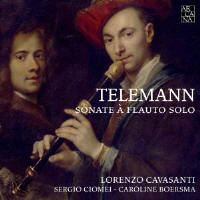Texte paru dans: / Appeared in: |
|
|
Outil de traduction ~ (Très approximatif) |
|
|
Reviewer: Raymond
Tuttle As the headnote indicates, four of these works were composed to be played either on a violin or on a flute, but that (so argues Lorenzo Cavasanti) should not stop musicians from playing them on a recorder, as he does here. In a few cases, this has necessitated key transpositions, which should ruffle only the most rigid purists. Cavasanti plays a different recorder in each sonata. There are four alto recorders (one of flamed boxwood, one of maple, and two of boxwood and ivory), a tenor recorder (maple), and a soprano recorder (grenadilla and ivory). (“Flamed” refers to a pattern in the wood grain—no one is setting recorders on fire!) There are subtle differences in their sound, and Cavasanti has attempted to match the color of the instrument to the character of the sonata. I doubt that most listeners will realize this, unless they themselves play recorders, but I don’t doubt that it makes a difference, at least on a subconscious level. As with most programs of Telemann’s music, the variety of styles allows you to play it from beginning to end without one sonata beginning to sound like another. At this very moment, for example, I am enjoying the virtuosic Allegro assai movement from the Sonata in B Minor, which has rustic bagpipe effects and strong rhythms. (One can imagine a teenager from the period, exclaiming in the manner of American Bandstand, “It hath a good beat; thou canst dance to it.”) The disc opens with the Sonata in G Minor—specifically, with a lovely, sighing Andante whose continuo descends chromatically over and over again. All six sonatas are in four movements, with alternating tempos, yet Telemann’s inventiveness means that the music never sounds formulaic. Together, these three musicians go by the name Tripla Concordia. I listed them individually, because that is how they appear on the front cover, and anyway, Cavasanti is the star of the show. He has complete control over his instruments; even sustained notes remain steady in pitch, with no deterioration in tonal quality. If, in the faster movements, his playing sometimes has a rather hard quality, I think that is a function of close microphone placement; compared to his two partners, especially the cellist, he is dominant.
There are
several programs of this type on other CDs, although no two approach
Telemann’s texts and musical challenges in quite the same way. Tripla
Concordia’s selection, and its healthily forthright playing, ensure that
this disc is an enjoyable one, and if this repertory appeals to you, then
this CD is an easy to recommend. | |
|
|
|
|
Cliquez l'un ou l'autre
bouton pour découvrir bien d'autres critiques de CD |
|




